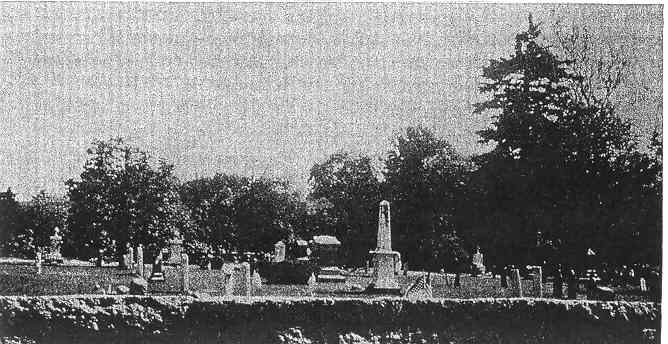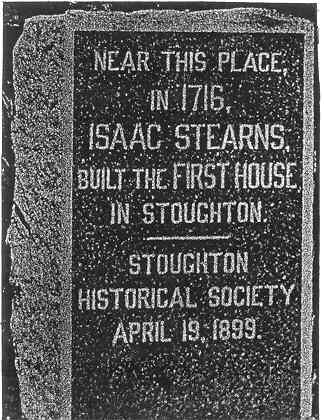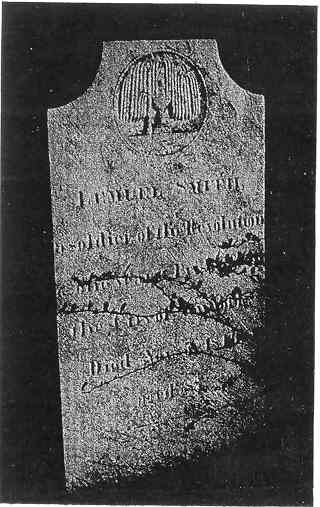
CHAPTER II
DRY POND

Dry Pond Cemetery
Although there are no remains of the first house built in present Stoughton, it is generally accepted that Deacon Isaac Stearns built it on West Street in 1716 even before the first road (West Street) was laid out. At the Dedication of the monument marking this first house, it was stated the first road was laid out over his [Stearns] path to the first parish meeting house at Canton Corner in 1733. An article on file in the Historical Society claims the original doorstep of Isaac Steams' house ties inside a bungalow built by Henry Britton near Britton's Pond.

Marker at Site of Isaac Stearns' House
Little is known about Isaac beyond the facts that he was a Deacon in the first parish, and that he brought five sons and four daughters here from Lexington, ranging from 19 year old twins, Isaac and, Simon, to a three-year old. The old homestead was later bought by Nathaniel, leaving half of the house for his father (old Isaac). A daughter, Elizabeth, married Edward Esty (called Dr.); they built a house on Pearl Street, and in 1733 built another on the south side of Dry Pond Cemetery (supposedly a cellar hole remained at the time of the dedication of the Isaac Stearns Monument.) Another daughter, Abigail, married Samuel Brackett in 1737. They lived at Dry Pond until Dr. Buckman died at Belcher's Corner, when they bought his house and moved in. Their daughter, Abigail, married John Belcher, Dr. Puffer, who delivered the address at the Dedication of the Monument in front of the old cellar hole (it was later moved back from the road) was a descendant of Deacon Stearns.
At 1212 West Street stands the house known as the Clapp house, whose history predates the occupation by the Clapp family. In the files of the Historical Society it is listed as standing in 1768, but the original owner's name was not given. In 1775, however, the owner was given as William Merion. Since these were the earliest recorded name and date, the Committee accepted them as official, even though it is likely the house stood in 1768. On the map of 1794 Nathaniel Merion is listed as owner of this house. Checking in Dry Pond Cemetery, a marker was discovered for William Merion, died in October, 1782, in his 59th year. The Merion heirs subsequently sold the property in 1821 to Charles Clapp, who is listed as owner on the official map of 1831
In this farmhouse Lucius Clapp was born; he remained a farmer on this huge and prosperous tract his life long, having inherited it from his father, Charles. Lucius was active in civic affairs, one of the leaders of his community, and public library benefactor. According to local historians, the house is substantially unchanged on the exterior from the time when Lucius Clapp lived there.
Behind the Clapp farm, one of Stoughton's fine granite quarries, owned by Myron Gilbert, yielded the stone for many iocai buildings, including the historic Stoughton Railroad Station.
A charming house with historic associations stands at 1261 West Street, which dates back to circa 1764; the present owner has traced the property to Simon Stearns, )r, in 1764-68. Noted on the 1775 map as belonging to Benjamin Gay, it is one of a string of houses along West Street which were owned by various members of the Cay family. Either this house or one "on or about the site" belonged to Jeremy Hixon in 1794. The Cays returned to ownership on the map of 1831, which seems to confirm the "about the site" of the small house of Jeremy Hixon
The house at 1261 is well known as the home of Myron Gilbert, owner of the nearby granite quarry behind Clapp's farm. Myron's son, Ernest, was married to the daughter of Erastus Smith, one of the partners in Stoughton's famous popcorn industry They lived in the attractive Smith homestead on the corner of Plain Street and Bay Road.
The house at 1404 West Street, originally built in 1764-68 by Turel Allen, has long been associated with farming. The 1790 Census lists "Turril Allen;" the 1794 map places Ture| Allen as the owner of the house at present-day 1404. But by 1831, Nathaniel Gay was the owner, dating him back to about 1768. Bertha Reynolds' Area Survey remarks that the area south of Plain Street contains the best agricultural land in Stoughton. The house at 1404 West Street has been occupied by the family of Charles McNamara, former Massachusetts Commissioner of Agriculture, for over 100 years. It is said to be the oldest working farm in Stoughton.
One of the finest restored farmhouses is at 1460 West Street. A focal historian reports the front part of the house is the original house; there is some discrepancy in the building dates but the Committee accepted the earliest, 1771, from the evidence in an old album at the Historical Society. This states the house was standing in 1771, although it listed no owner or building date. In 1775, the owner was given as William Lonnon, who had purchased the land in 1749. The house does not appear on the map of 1794. On the map of 1831, the owner was Jesse Gay; this name is recorded as original owner since tradition has always called this one of the Gays' farms. The Historical Society File dates the original Gay house at 1800; it is possible an 1800 building replaced the 1771 house noted as standing. A recent owner (Mrs. Sharkey) had a paper which listed it on the tax list of 1802, but had no previous documentation. This magnificent old house was also known locally as the Hurley Farm.
Farther down the road stands another homestead, at 1546 West Street, belonging originally to one of the Gays. There is little doubt this home was built in 1767 by Timothy Cay, 2nd, son of Hezekiah Cay. It was listed as standing in 1771, and appears on the map of 1794 as the Timothy Cay house. The William Capen collection in the Historical Society also lists this in a compilation of houses built before 1800 still standing in 1932. On the map of 1831 the owner is ). Jones; the farm is also known as the "Jefferson Jones place." In recent times it was the homestead of the Williams family, who became prominent in the community.
One of the better known houses in the Dry Pond area is the birthplace of Henry L. Pierce, 55 Highland Street. The original house was built by William Smith, 2nd, in 1764, according to the 1929 survey from the Historical Society. The William Capen file states the house originally stood on Bay Road, built around 1750, where Lemuel Smith was born about 1759. It was later moved and attached to the house at 55 Highland Street. This is a prime example of confusing dates due to moving and partitioning houses. In all probability, the small house from Bay Road was attached to the house at 55 Highland Street sometime after that was built in 1764. The map of 1794 shows Joseph Smith, Jr. as owner of the house on this site; the 1831 map shows J. Pierce now the owner, with a mark for L Smith still on Bay Road.

Lemuel Smith's gravestone
Dry Pond Cemetery
According to Huntoon, Jesse Pierce was born in Canton in 1751, and moved to Stoughton in 1799, placing him rightly in the house on Highland Street belonging to J. Pierce in 1831. William Capen said Colonel Jesse Pierce enlarged the house in 1824, and "being a man of culture, taught a boys' school there, using Uncle Lemuel's house for a schoolroom." Jesse's son, Henry L., was born in the house on Highland Street and rose to prominence in the political world. The Honorable Henry L, Pierce was Mayor of Boston, a Representative to Congress, and is remembered as a benefactor of the Stoughton Public Library. He later moved back to Canton and made a fine estate of the old Redman farm.
"Uncle Lemuel" was himself a notable figure.. He enlisted in the Revolutionary War at the age of 16 and fought in many places before he was captured in New York. Released, he walked home "through the wilderness" and lived to the ripe old age of 87. He is buried with other Revolutionary soldiers in Dry Pond Cemetery.
Just below Highland Street on Bay Road is a house which has had many owners, making "in interesting research. 1888 Bay Road was originally built in 1761 by Ephraim Payson, jr., according to both William Capen and the town list derived from the map of 1775. By 1794, it belonged to William Austin, whose name is often associated with it 8y the time of the map of 1831, Nathan Warren had the Austin house In 1854, it was owned by William Littlefield; for many years it was known as the Littlefield Place, Its present owner says it has been called the "lightning house" because it has been struck so many times. The latest fire, in 1970, caused extensive damage to the interior; the carpenters repairing it confirmed its age by the construction exposed.
At 1528 Bay Road stands another house which remained for many years in the Cay family. It was built in 1767 by Hezekiah Cay, Jr., according to the town list of houses standing in 1775 and also in the album of old houses in the Historical Society, which states it was standing there in 1768. On the 1794 map Aaron Gay, who is assumed to be a son, was the owner. In 1831 an F. Gay owned the house. The Aaron Gay who was later a partner in the popcorn business, and also lived on Bay Road, was probably a descendant of this family.
The small house at 750 Bay Road, built by William Drake, was dated about 1775. A recent owner claimed a much earlier date, but so far this has not been documented The town list pieces it on the map of 1775, although the William Capen file dates it at 1778, An early map, 1749, does not show a William Drake house here, its building date is probably somewhere between 1750 and 1775, A William Drake is among the soldiers listed in the files either in 1755 or 1775. Both the 1794 and 1831 maps show the William Drake home at this location. The interior of this old house has some interesting features such as hiding places and fireplaces
Little is known about the house at 652-656 Bay Road beyond its builder's name, Russell Drake. It was originally a single dwelling, later possibly added on and made into a two family house. A large chimney bears the date 1822, and it does appear on the 1831 town list.
Coming from Bay Road toward the center of Stoughton, one traverses the old "Dry Pond Road," now Plain Street. On the corner of Bay Road and Plain Street is the Smith homestead at 925 Plain Street Although the Capen file dates this James Smith house at 1800, the 7794 map shows the lames Smith home at the same location; the Committee chose to go with 1794 on this authority. In 1831 J. E. Smith is the owner on this site. The house faces on both Bay Road and Plain Street, with two charming fronts Noteworthy in 1976 was a huge tulip tree on the Plain Street side.
Erastus Smith, later residing in the homestead, ran his popcorn business in the small shop beside the house on Bay Road. Each of the partners in this popcorn industry packaged the corn in his own house; Smith in his shed, Mr. Clapp farther down on Bay Road, and Aaron Cay in his small house beyond the cemetery on Bay Road
When Myron Gilbert's quarry supplied the granite for the Railroad Station in the 1880's, it was hauled from West Street down Plain Street, which was then located slightly differently from its present road bed in that area. Myron's son, Ernest, married Amy, the daughter of Erastus Smith, and they subsequently lived for many years in the old homestead it was known as the Gilbert house in later years An interesting note comes from Amy Wade Tirrell; her father hauled the Stone for Mr. Gilbert for the Railroad Station; when she was born, Amy Smith Gilbert named her Amy. As a girl, Amy Wade worked many hours for Mr. Smith packaging popcorn by hand.
Tradition also locates this house as one of several stations on the Underground Railroad in Stoughton, but this has not been proven to date.
At the corner of Plain and West Streets. 725 Plain Street is the home of Jesse Smith, built in 1769. The album in the Historical Society called the original owner Josiah Johnson, but nowhere else does that name seem to appear The 1794 map names Jesse Smith [the house is not marked on the 1749 map, even though one owner claimed the house dated back to about 1724] as the owner At any rate, the corner apparently was mainly inhabited by Smiths; the old Dry Pond School diagonally across from Jesse Smith's "tiny white house" was once called the Smith school.
An outstanding house at 423 Plain Street was built by Nathaniel Holmes, Jr. in 1756. The Album says Holmes, Sr, but all other data refer to him as Jr. The Capen file says the house is shown on the 1775 map as having been built in 1756 by Nath. Holmes, Jr.; succeeding maps show Philip Holmes and J. Holmes as owners in this area. The original house is a small part of the present elegant home, it was added to in 1806, and again in recent times A large farm was operated here for many years; locally it is known as the Farrington Farm.
Back to the Table of Contents To the next section...
Back to the main page of www.StoughtonHistory.com